The Samsung Galaxy Note7 (S820) Review
by Joshua Ho on August 16, 2016 9:00 AM ESTSystem Performance Cont'd
Now that we've covered more general purpose benchmarks that tend to emphasize CPU performance and GPU compute performance, we can look at benchmarks that tend to more strongly emphasize things that games will see benefits from such as improved GPU graphics performance and improved CPU physics processing performance.
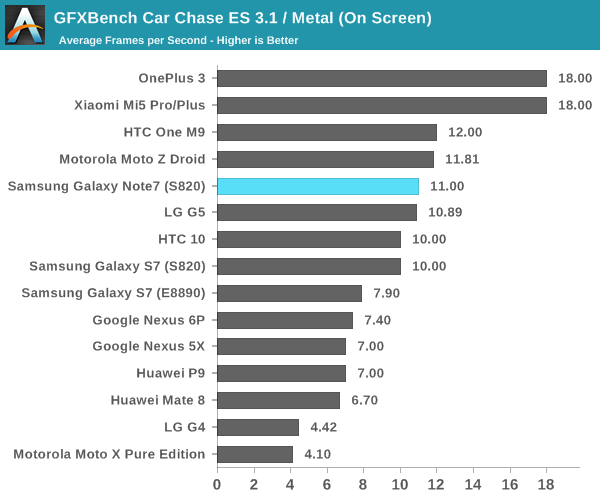
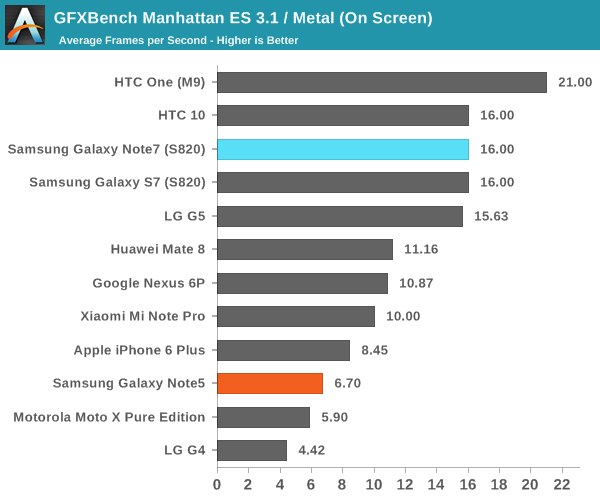
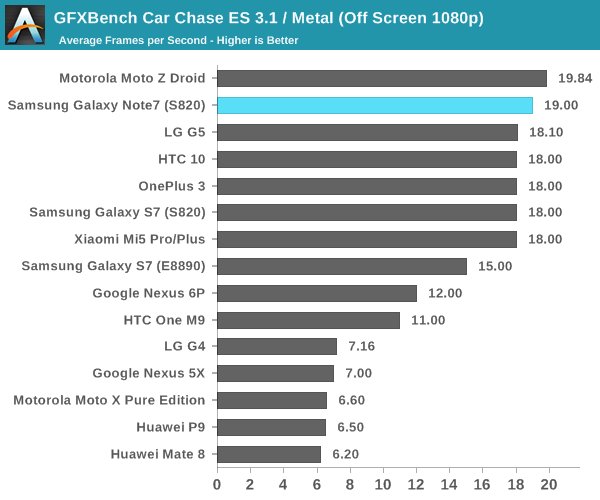
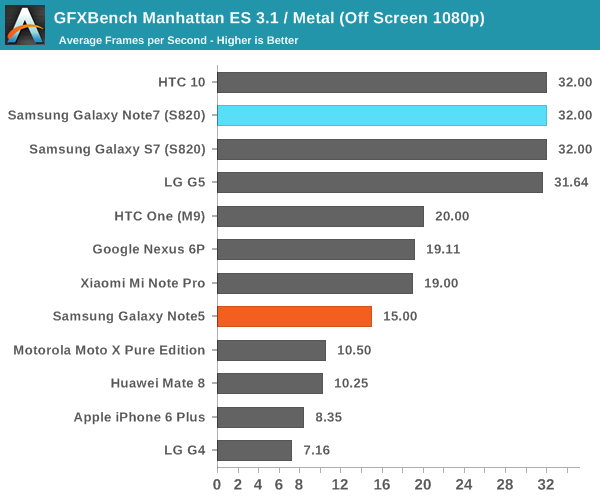

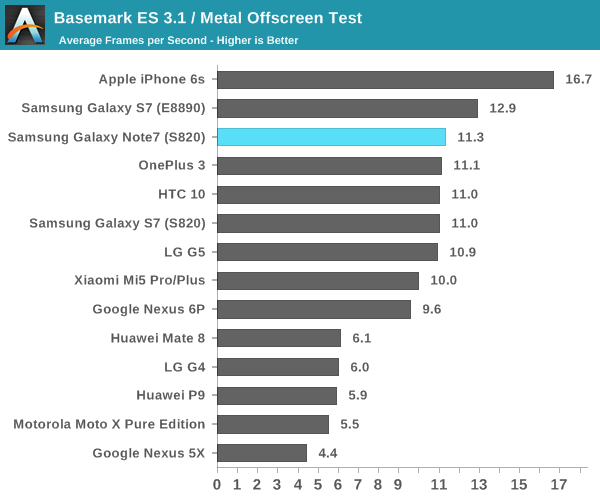
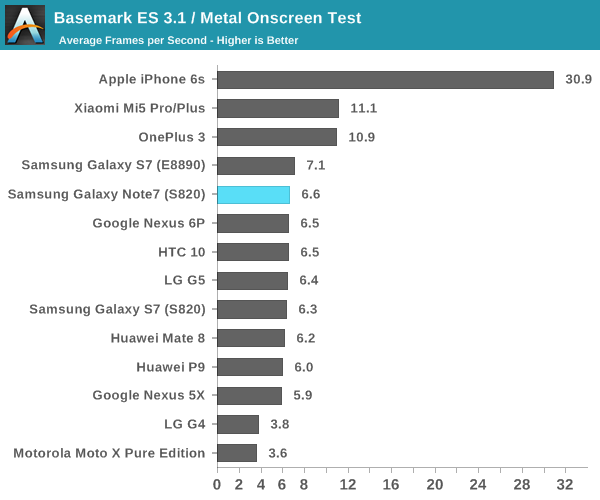
It's probably no surprise, but the Galaxy Note7 performs as expected with the latest drivers and in ideal thermal conditions. The Adreno 530 should be more than sufficient for the forseeable future but for maximum performance it's best to enable 1080p rendering or lower to maximize frame rates in games like Real Racing 3 that tend to really use the GPU to its fullest extent.
NAND Performance
Of course, while Discomark provides a sort of holistic view of performance for a specific task, it’s also important to at least try and break down the various aspects that impact system performance so rather than simple black box testing we can further understand what factors influence performance and therefore provide additional information to make better buying decisions. One of the major contributors to general purpose performance is going to be storage performance, which is often something often ignored by marketing as the nitty gritty details of NAND storage realistically require some background in solid state physics and devices to understand, as well as some understanding of computer science and engineering.
While I’m not really happy with the state of our mobile storage benchmarks, for now I don’t really see another option here as the publicly available storage benchmarks for Android and iOS are fairly basic. Putting aside the state of the benchmarking industry, our current benchmark remains AndroBench 4 which provides at least some basic storage benchmarking capabilities. We use custom settings with this benchmark which attempts to make the test more realistic as the default settings are just wildly unrealistic. This includes adjusting the buffer size, increasing the file size to 100 MB, and only using one thread instead of 8. 256KB file size is targeted as this is the most common block size if you profile this kind of thing for sequential writes and reads, while 4KB block sizes are the most common for other tasks as the vast majority of computer architectures use 4KB pages for virtual memory. Single-threaded I/O is common in most cases because multi-threaded programming is still difficult for most people to reason about in an effective manner because conscious thought is inherently serial in nature with some multiplexing. In addition to this, many eMMC solutions on the market don’t really perform well with multiple threads simultaneously as the controller can’t do anything with extra requests other than reply with a busy signal which already happens with a single thread.
Putting aside discussions of testing we can take a look at the storage solution used in the Galaxy Note7 before getting into the actual results. The Note7 continues to use basically the same storage solution as the Galaxy S7 and S6, which is to say an MLC-based solution that has a UFS Gear 3 single lane interface for bandwidth up to 600 MB/s and basically has the exact same model number if you check the SCSI devices attached to the system save for some changes that indicate the higher 64GB storage relative to the 32GB chips that are most common in the Galaxy S7.
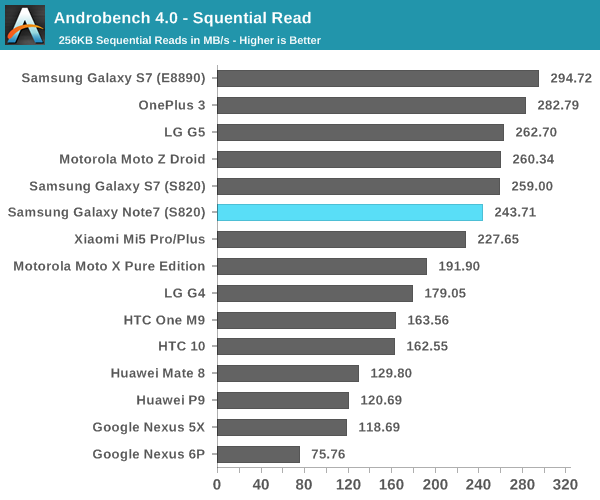

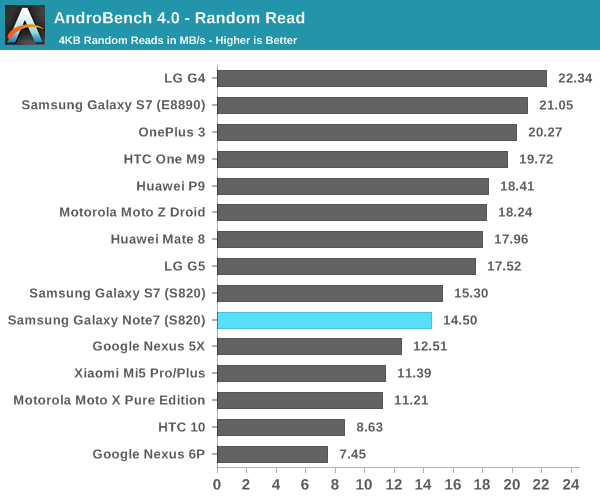
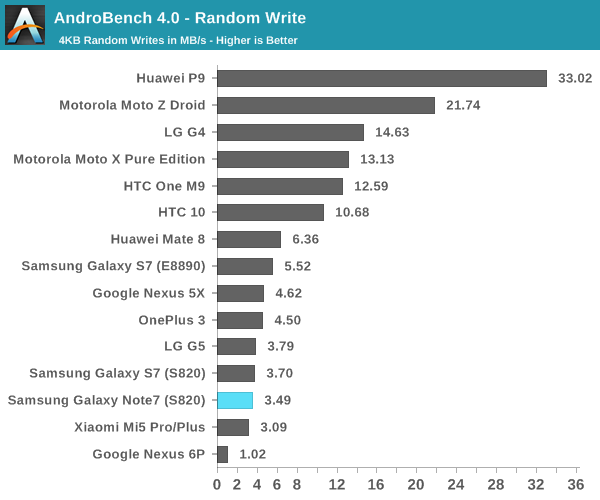
Looking at the test results it performs exactly as quickly as you’d expect from this MLC solution as we’ve tested it in the Galaxy S6, S6 edge, S6 edge+, Note5, S7, S7 edge, and now the Note7 as well as the LG G5. The performance here is acceptable but obviously if you look at burst performance the iPhone 6s has a faster solution due to the hybrid SLC/TLC storage solution. The main benefit of pure MLC NAND is that performance is more consistent as there’s no precipitous drop when the SLC buffer fills. There’s always room to improve but I don’t really see how it’s going to happen unless Samsung moves to V-NAND for the next generation.










202 Comments
View All Comments
thunderwave_2 - Thursday, August 18, 2016 - link
Look at the S7 Exynos stock browser results. Yes, the iPhone 6s still outperforms it, but it isn't exactly "wiping the floor" with it.Also, consider that although the onscreen benchmarks seem to be in its favour, the S7 is rendering almost 4 times the pixels. While the Mali T880/Adreno 530 is ahead though, the iPhone 6s does admittedly have superior sustained performance.
iOS runs less background processes and is less resource intensive than Android, leading to the great battery figures.
trparky - Saturday, August 20, 2016 - link
Which tells me that Samsung didn't equip the device with a strong enough GPU to push the amount of pixels and sustain high frame rates. If you ask me, there's no reason why that device should have such a high pixel count. Once you go past a certain point it becomes nothing but bragging rights.As for iOS running less background processes, that's a good thing. Yeah, Android is pretty bloated under the hood. And then you throw Samsung's garbage on top and you make it even worse. Android's not nearly as optimized as iOS is.
slyronit - Tuesday, August 23, 2016 - link
The device has a high pixel count because it uses a Pentile display, so the effective resolution is always less than advertised. A Pentile 1080p on such a big screen would look like crap.lilmoe - Tuesday, August 16, 2016 - link
It was surpassed in performance and efficiency a long time ago, by the Exynos 7420... The 8890 widened the gap further.I know you guys want to believe that Apple's chips are the best. I feel your pain. But it's not, no matter how many "reviewers" preach browser benchmarks. Geekbench is by no means a legit benchmark. lol.
Even on the GPU side, the PowerVR has long been surpassed.
Stop blaming Google's shortcomings on Samsung, Qualcom and others. Google's _services_ are great, but their software and optimization level is absolute brown stuff. Samsung, LG and everyone else has to literally fix Android before releasing a phone/update...
CloudWiz - Tuesday, August 16, 2016 - link
Performance...only in multi-threaded benchmarks. Twister absolutely destroys A57 in any single-threaded benchmark and since for the vast majority of use cases (i.e. web browsing) the OS only uses one core, the overall user experience is so much better with the A9. Mongoose is catching up but still not at Twister's level.As for efficiency, the modem on the S6 makes it last a ridiculously short amount of time on LTE and even on Wifi the 6s lasts half an hour longer with a battery two-thirds the size of the S6. The 6s Plus lasts a full 2 hours longer with a similar size battery.
The GT7600 was only beaten in GFXBench this year by the Adreno 530 and surpasses both Adreno 530 and the T880MP12 in Basemark (it also has equal performance to the T880 in Manhattan). You make it sound like the GT7600 is multiple generations behind while it is not. It absolutely crushes the Adreno 430 and the T760MP8 in the Exynos 7420. The GX6450 in the A8 was underpowered but the GT7600 is not.
I do hope that at some point Apple adds two Cortex-A53s to help with low power tasks, but given that their dual-core design already achieves insanely good performance (with the A10 seeking to equal the performance of A9X in a mobile device), they might not even need to.
lilmoe - Tuesday, August 16, 2016 - link
"and since for the vast majority of use cases (i.e. web browsing) the OS only uses one core"False. On Android, the vast majority of applications take full advantage of 4 or more cores.
"As for efficiency, the modem on the S6 makes it last a ridiculously short amount of time on LTE and even on Wifi the 6s lasts half an hour longer with a battery two-thirds the size of the S6. The 6s Plus lasts a full 2 hours longer with a similar size battery."
Also, false. As proven by personal experience, with good reception, the modem on the modern Exynos chips can be more efficient than WiFi. What you're seeing in the charts, my friend, is that Safair (or any browser for the matter), is more efficient that Chrome (shocker). What you're also seeing is that, 720p and 1080p are more battery friendly than 1440p (another shocker). It's amazing that the GS6/GS7 can keep up with that much overhead and more pixels to push.
osxandwindows - Wednesday, August 17, 2016 - link
Not really, those cores are waisted cores.The scheduler sucks, therefore making android inefficient overall when it comes to the use of multiple cores.
thunderwave_2 - Thursday, August 18, 2016 - link
http://www.anandtech.com/show/9518/the-mobile-cpu-...This piece shows that, on the S6 at least, not all of those cores go to waste.
osxandwindows - Thursday, August 18, 2016 - link
Nope, you don't get it.osxandwindows - Thursday, August 18, 2016 - link
I'm not saying it can't use them, I'm saying it can't use them an a way that doesn't affect performance or battery life.